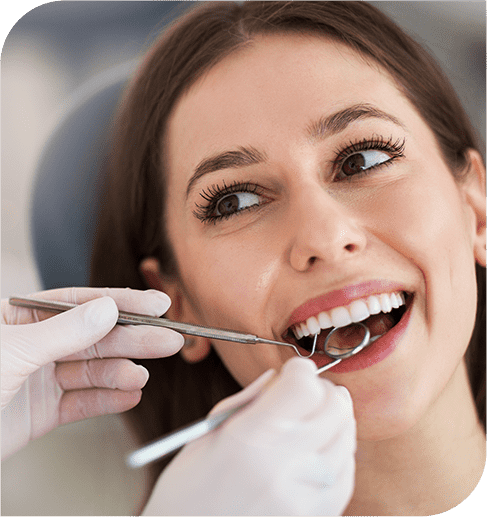Losing one or several teeth creates gaps between your teeth that could result in dental problems like jawbone disintegration. For many years, dental crowns and bridges have been the best solutions for lost teeth by filling the gaps left after teeth fall off. Dental crowns and bridges can be made from different materials, including gold, porcelain, or alloys. Dental crowns and bridges are needed to improve your smile's aesthetic and functionality if you have one or several missing teeth. For the best quality dental crowns and bridges in Santa Clarita, we invite you to contact Valencia Advanced Dentistry at Copperhill Smiles.
How Dental Crowns and Bridges Work
A dental crown typically caps a damaged, decayed, or weak tooth. Crowns also come in handy for maintaining a tooth's size, strength, appearance, and shape. If you have a missing tooth, your dentist can recommend a dental implant as a tooth root. Upon placing the dental implant in the jawbone, the dentist places an abutment and a dental crown. Dental crowns can be customized to match the color of your natural teeth to ensure they blend in with the other teeth.
A dental crown can contain several materials, but porcelain and gold alloy are most commonly used. Acrylic and ceramic crowns can also be helpful because they match the original teeth. Most people opt for acrylic and ceramic crowns because they are long-lasting.
On the other hand, a dental bridge consists of two crowns, one on each end, and a bridge of replacement teeth that sit on the gums in the area with missing teeth. The crowns on each side of a dental bridge fuse to the existing teeth. Dental bridges are solely for replacing missing teeth.
Types of Crowns and Bridges
Understanding the different types of crowns and bridges, including their benefits, is essential to making the best choice. Below are the common types of dental crowns and their benefits:
Gold Crowns and Gold Alloy
For thousands of years, gold has been used in dentistry to repair worn-out teeth. Dentists combine gold with other metals, including nickel, palladium, or chromium, to increase the strength of the gold crowns and make them more affordable. Gold and gold alloy crowns can appear gold or silver in color. The crowns are sturdy and will rarely break or chip. Since these crowns require minimal tooth removal during application, they do not wear down quickly. If well taken care of, the crowns could last for decades.
The only limitation of gold and gold alloy crowns is their metallic color, which makes them look artificial. Most people put these crowns on their molars because they are less visible.
Stainless Steel
Usually, stainless steel crowns are used in children to restore the primary teeth of children who have undergone pulp therapy, also known as root canal treatment. They are not meant to be permanent and are usually lost with the primary teeth. A stainless steel crown can also come in handy if a temporary crown is required to protect the tooth between the preparation and placement of a permanent dental crown.
Metal Dental Crowns
As their name suggests, metal crowns are entirely made of metal, meaning they have a metallic appearance. Different types of metal can be used to make metal crowns, including copper, platinum, gold, and base metals like nickel-chromium and cobalt-chromium. Most metal crowns consist of precious metals and base metal alloys. Since metal crowns are extremely strong, they are ideal for restoring the molars. Another advantage of metal crowns is that they do not wear out the opposing teeth. If you are conscious of the appearance of metal crowns, you can have them fitted on the teeth at the back of your mouth, where they are not visible. Other than the metallic appearance, another limitation of metal crowns is that they corrode over time.
All-Porcelain Dental Crowns
Also known as all-ceramic dental crowns, all-porcelain crowns are made using porcelain and ceramics. They are an excellent option if you are allergic to metal because they are metal-free. Dentists can color-match porcelain crowns to the natural color of your teeth. Due to their natural appearance, dentists usually use porcelain crowns to improve the teeth' size, shape, and color. The only limitation of all-porcelain crowns is that they lack the strength of metal crowns. All-porcelain crowns can also wear down the opposing teeth.
All-Resin Dental Crowns
Compared to other types of dental crowns, all-resin crowns are the most affordable. They are made from dental composite resin. Your dentist can color-match resin crowns to match your surrounding teeth. The main advantage of all-resin dental crowns is their ease of installation because they require minimal tooth preparation. The downside of resin dental crowns is that they are weaker than others, making them more susceptible to damage.
Porcelain-Fused-To-Metal Fused Dental Crowns
Unlike regular porcelain, porcelain-fused-to-metal is stronger because it is attached to a metal structure. Dentists usually use these crowns to fix front teeth, as porcelain blends well with the patient's teeth' natural color. Dentists prefer porcelain, mainly if the affected tooth lies in the front part of the mouth.
Types of Dental Bridges
Dental bridges replace lost teeth, whether the teeth have been removed due to structural damage or tooth decay. Your dentist can put a bridge on top of the gap left by the lost tooth. The teeth on the side serve as anchors, and the gaps in the middle are replaced with fake teeth. Dental bridges usually have a natural appearance after placement.
The common types of dental bridges include:
Traditional Dental Bridges
Traditional dental bridges are the most common type of dental bridge. They are cemented onto the tooth next to the gap. Dental crowns are used to keep the fake teeth in position. Dentists extract the enamel adjacent to a patient's tooth to fix traditional bridges and allow the crown to be placed on top. The main advantage of conventional bridges is that they are strong and long-lasting.
Implant-Supported Bridges
Implant-supported bridges have a similar structure as traditional bridges. The only difference is that they are held in position with dental implants. Usually, you can use Implant-supported bridges if you have lost more than one tooth. Your dentist can place an implant for each lost tooth.
Maryland Bridges
Maryland bridges have a porcelain or metal framework that keeps the pontic in position. The metal is cemented onto the backs of the two teeth next to the gap. The metal eliminates the need to shape the adjacent tooth and adhere to it. The strength of a dental bridge depends on the resin that keeps it in place. Maryland's bonded bridges are strong, affordable, and conservative.
Cantilever Bridges
Cantilever bridges are similar to traditional bridges. The only difference is that one side of the fake tooth has dental crowns supporting it. Cantilever bridges are popular with patients who have one missing tooth with a natural tooth next to it. If cantilever bridges are correctly installed, they save both money and time.
The Procedure For Crowns And Bridges
Most people know about terms like crowns, bridges, and dental implants. However, most people need help understanding the procedure for placing dental crowns and bridges. Understanding the crown and bridge procedure is necessary to know what to expect.
Before installing dental crowns and bridges, you will consult your dentist. The dentist will clarify the treatment procedure, expected treatment time, and cost during this consultation.
Ask all the relevant questions now, including whether your dental insurance will cover the procedure. If you have underlying health conditions, you should reveal this information to your dentist during the initial consultation. Some patients require pre-medication before the treatment. Your dentist can also advise you to stop taking specific medications several days before the dental crown and bridge procedure.
Placing dental crowns and bridges involves several steps, requiring several dental appointments. The dentist will prepare your teeth during the first appointment. The preparation includes re-contouring either side of the gap after the tooth preparation. Your dentist could extract a section of the enamel before placing the crown over the tooth.
Your dentist will take an impression of the tooth and create a model. The dentist sends the model to the dental lab to make a bridge or a crown.
Your dentist will likely create a temporary crown or bridge for you to wear until your next appointment as you await the permanent crown. The purpose of the temporary crown is to cushion your teeth against germs until the dentist receives the permanent crown from the lab.
At your second dental appointment, your dentist will extract the temporary crown and replace it with a new one. The dentist will adjust the crown to ensure it fits perfectly on the tooth.
You will require several visits to the dentist to ensure the crowns or bridges fit correctly. The number of visits you make to the dentist will depend on your dental needs, including the number of teeth involved. It will take two weeks for the fixed crowns or bridges to be fully cemented. After two weeks, you will have a dental appointment during which your dentist will determine if the crowns or bridges fit well.
You might be wondering whether dental crowns and bridgework hurt. Your dentist will administer anesthesia, so you will not experience discomfort or pain during treatment. You will only experience gum soreness and tooth sensitivity following the treatment, which will disappear after a few days.
Advantages Of Dental Crowns And Bridges
You will enjoy several advantages when you undergo dental crown and bridge procedures. They include:
Chewing And Speaking
Usually, it becomes hard to chew certain foods when you lose a tooth. Pronouncing certain words could also be problematic when you have gaps in your mouth. Dental crowns and bridges will solve these problems. You will chew and speak properly when you undergo dental crown and bridge procedures.
Prevent Your Teeth From Shifting
Your teeth will be held in their natural position by crowns and bridges. If you replace a lost tooth with a crown or a bridge, the original teeth will remain in their original position. Failing to replace lost teeth could cause neighboring teeth to shift and lead to jawbone loss.
Smile Restoration
When you have missing teeth, you can feel conscious when smiling and fear that people will notice the unsightly gaps. Dental crowns and bridges can restore or give you the perfect smile you have always desired. With a beautiful smile, you no longer have to shy away from people, which will significantly improve the quality of your life. Most people acquire dental crowns and bridges purely for cosmetic reasons.
Signs That You Need Dental Crowns Or Bridges
Several reasons could cause you to need crowns or bridges. Some of the common signs that you need dental crowns or bridges include:
Suffering From Cracked Tooth Syndrome
This is a situation where you have a cracked tooth, but the tooth is not broken. You can experience sharp pain when you chew or bite food. Most patients with this problem experience pain only when chewing or biting. Other patients could be sensitive to hot or cold temperatures. Putting a crown over your cracked tooth could prevent cracked tooth syndrome and protect against future tooth damage.
Having Root Canal Therapy
You could require root canal therapy if your nerve tissues and the inner pulp become infected. During the therapy, your dentist can remove the decayed sections from the affected tissues. The treatment, therefore, leaves the tooth at a high risk of breaking. Following a root canal treatment, you will need a dental crown to prevent the tooth from disintegrating. A dental crown will hold the tooth together, keeping it intact even as you chew food.
Having A New Decay On a Tooth With a Filling
When your dentist treats tooth decay with dental fillings, tooth decay could still recur over time, whether the dentist uses composite or silver amalgam fillings. When tooth decay occurs beneath the dental fillings, your dentist can use another dental filling to treat the decay. However, in most cases, the dental issue must be treated with crowns or bridges. Usually, the dentist places a subsequent filling over the tooth, which could make the tooth weak, leaving it susceptible to breakage.
Broken Teeth
A broken tooth could affect your oral health and lead to pain. If a broken tooth is not treated immediately, it could become severely damaged and result in tooth extraction. Dental crowns could be the best option if you suffer from a fractured tooth and do not need extraction. A crown can cover the broken tooth fully. A crown helps you avoid further tooth damage and restore the teeth' structure, strength, and appearance.
How To Take Care Of Dental Crowns And Bridges
One of the most effective ways to care for your dental crowns and bridges is to follow the dentist's instructions. After the dental crowns and bridges treatment, your dentist will give you some home care tips to enhance the durability of your dental crowns and bridges. You should contact your dentist if you notice anything unusual following a dental treatment.
The following are the measures you should take to take care of crowns and dental bridges:
Avoid Eating Until The Numbness Wears Off
Depending on the quantity of local anesthesia your dentist used, you could experience numbness for several hours after the dental procedure. You must be careful and avoid eating until the numbness clears. Avoid chewing to ensure you do not accidentally bite your tongue, cheek, or lip. When the numbness wears off, you should start with a soft diet. In the first few days following the treatment, you should avoid chewing on the side where the treatment was done.
Pay Attention To Your Bite
After a few days, you will get used to the dental crowns and bridges. However, sometimes, you will need adjustments to the crowns and bridges. If you experience persistent, dull aches, you should contact your dentist. A slight adjustment of the bridges can always make a significant difference.
Avoid Chewing Or Biting Hard Foods And Objects
Dental crowns and bridges cannot withstand the pressure of chewing or biting hard foods or objects, even if they function like natural teeth. Chewing or biting hard foods or objects can cause severe damage to both your original teeth and dental crowns or bridges.
Regular Visits To Your Dentist
Visit your dentist regularly, besides observing good oral health care practices in the comfort of your home. Your dentist will examine you and monitor your progress during the visits. If your dentist detects any problems with your crowns or bridges, he/she will correct it immediately.
Use Pain Relievers When Needed
You could experience mild discomfort following a dental crown and bridge procedure. The first few days after the dental procedure, you could experience aches or soreness. You can use painkillers like Ibuprofen or Tylenol to relieve the pain. However, you should contact your dentist if the pain persists because this could be a sign of infection or failed dental crowns and bridges.
Brush And Floss Your Teeth Regularly
While cleaning your crowns or bridges, treat them just like your natural teeth. Dental crowns and bridges are strong and secure, so you can brush and floss as usual. Always aim to brush your teeth at least twice a day. Flossing helps remove accumulated food and other dirt from hard-to-reach areas.
How Long Will Your Dental Crowns And Bridges Last?
Your dental crowns or bridges could last years if you practice proper dental hygiene. First, you must brush your crowns and bridges at least twice daily. You could also use other necessary products, like antimicrobial mouth rinses. Dental crowns and bridges can last up to fifteen years, provided you take good care of them.
Dental crowns and bridges could fall or weaken if you chew ice, hard foods, or other objects. Your crowns or bridges could also fall because of periodontal disease or bone loss. You should consult your dentist whenever you experience a dental crown or bridge problem.
Complications Of Dental Crowns And Bridges
The complications of dental crowns and bridges are rare, especially if the foundation of the crowns and bridges is a dental implant. In addition, complications are rare when an experienced dental expert performs the dental crown and bridge procedure.
If complications arise, they usually occur soon after the dental procedure. Therefore, it is essential to understand the risks and complications of dental crowns or bridges to help you identify the warning signs. Here are the warning signs of dental crown and bridge complications:
- Continuous swelling or a yellow discharge, which could be a sign of an infection or dental abscess.
- Severe pain after the dental procedure.
Food sticking below the crown or bridge is one of the most common problems with dental crowns or bridges. Food could stick if the crown or bridge is fitted poorly. Food buildup could promote bacterial growth, causing diseases or infections. You should consult your dentist if you experience severe sensitivity or pain following a dental crown and bridge procedure.
The Cost of Dental Crowns and Bridges
The cost of dental crowns or bridges varies depending on the following factors:
- The teeth being restored.
- The materials used.
- Whether your teeth require building up first.
Your cosmetic dentist will review your treatment plan, discuss the costs, and determine whether your dental insurance will pay for the procedure. Your dentist could also be willing to discuss a repayment plan with you.
Find a Dental Expert Near Me
Dental crowns and bridges are incredible for people with broken or missing teeth. They restore their confidence and give them a beautiful smile. With advanced dental technology, dentists can design dental crowns and bridges to appear like natural teeth. If you have broken or missing teeth and need reliable cosmetic dental services, contact Valencia Dentist. Our experienced cosmetic dentists provide compassionate and patient-centered dental care in Santa Clarita. We will go out of our way to give you the beautiful smile you have always desired. Contact us at 661-775-7717 to speak to one of our dentists.





